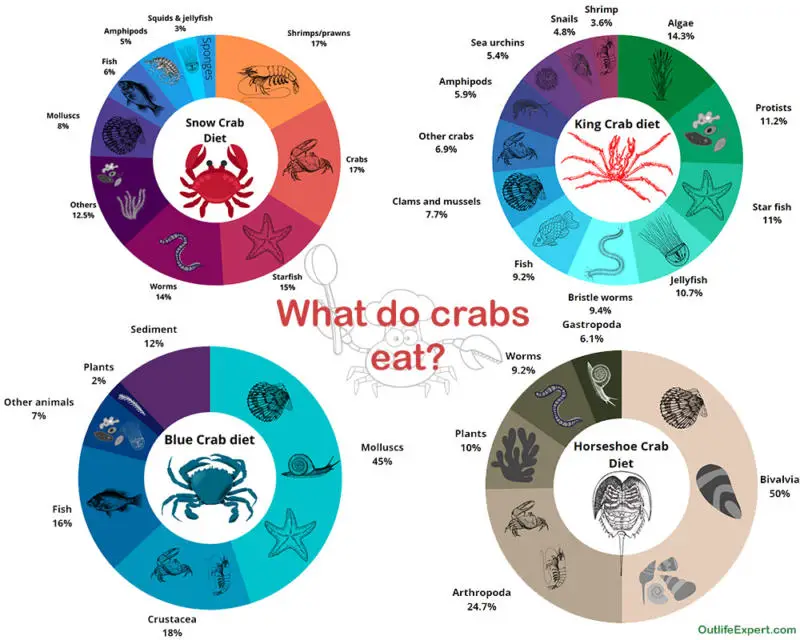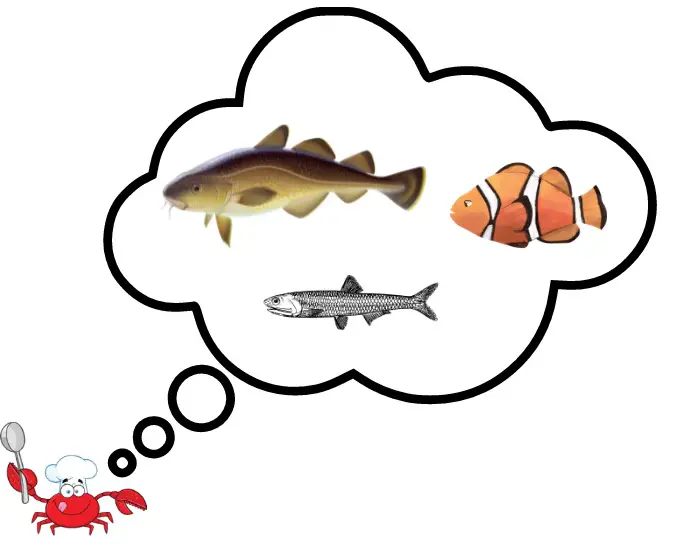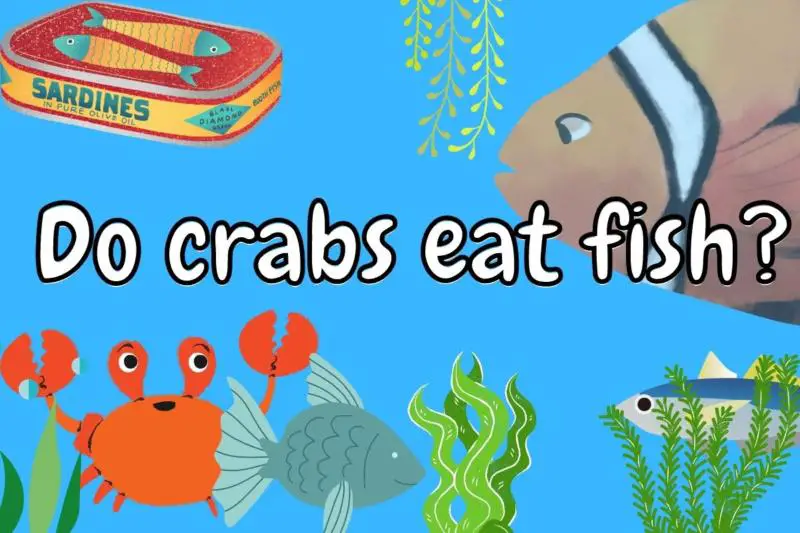There are over 4500 species of crabs, most of which are scavengers, meaning that they will eat anything in the wild environment, dead or alive.
Crabs are omnivorous crustaceans that eat a varied diet that includes many of the animals living in the sea. The primary dietary items of crabs consist of mollusks, other crustaceans, worms, algae/seaweed, and, to some extent, also fish.
As seen from the figure below, fish makes up a minor but important part of around 10% of the diet of most larger crabs like the Blue Crab (16%), the King Crab (9%) and the Snow Crab (6%). As most fish are too fast to be caught alive by most crabs, crabs prefer to eat injured or dead fish.

Contents
Where Do Crabs Look for Food?
The diet of a crab varies, depending on where the crab’s habitat is located. Crabs can be found all over the world’s oceans, as well as in freshwater bodies in tropical and sub-tropical regions, and on land.
Golden, blue and red Alaskan king crabs are a few examples of crabs that can be found in the deep oceans. Golden Alaskan king crabs prefer a habitat composed of soft corals and boulders, where they can easily scavenge their food, while the blue and red Alaskan king crabs prefer muddy or sandy floors.
Freshwater crabs such as the fiddler crab and red claw crab can live in a wide range of freshwater bodies, including lakes, swamps, and fast-flowing rivers. These crabs mostly feed on dead fish and algae.
Land crabs (hermit, yellow land, red rock) live in sand or soil burrows that can be several feet deep. These burrows can be found in cool, dark, and damp places to decrease water evaporation from the crab’s gills. Sandy beach coastlines, mangrove forests, swamps, rocky shores are some places where these burrows are found. Their diet of land crabs consists of small, nesting seabirds and fish.
How Do Crabs Hunt for Fish?
Crabs normally live in dark places where it’s hard to hunt prey by eyesight, which is why they primarily depend on their sense of smell and taste to hunt.
They have chemoreceptors to detect chemicals released by their prey in the water. These chemoreceptors are located on their antennae (the long, segmented appendages near the eyes) to perceive their surroundings.
Crabs also have smaller, antennae-like appendages near the antennas called antennules, which further help them sense their environment.
The hair present on a crab’s mouth, pincers and feet allows it to “taste” the chemicals which waft out from their prey.
How well a crab can detect its prey, depends on the water flow conditions. According to a 2009 report by Mark Hay, a biology professor, blue crabs excellently track their prey in low-velocity flows, but struggle in high-velocity, turbulent flows.
How Do Crabs Eat fish?
Crabs have a number of modified appendages for cutting, picking, sorting and pulverizing food. They use their large pincers for grasping and tearing the food into smaller bites to put it in their mouths more easily.
Crabs don’t have teeth in their mouths to breakdown their food, so breaking their prey into smaller bites to swallow whole is important.
Can crabs kill fish?
Yes as seen in the video above, they will eat living fish and occasionally even try to catch living fish swimming by, but they do rarely succeed. Healthy fish are most often too fast and alert for most crabs to catch, so crabs will seek out injured or sick fish because these are easier to catch.
Smaller crabs, such as the hermit crab, are opportunistic hunters. They will not attack large, live fish, but will absolutely prey on fish that are sick or dying.
Larger crabs, like the Red Starry Hermit, the blue crab or king crab may attack and eat live fish.
Do Crabs Eat Small or Large Fish?
Generally, crabs eat small fish. Larger fish, such as salmon, dogfish, sharks, striped bass, and many more are frequent predators of crabs. They mostly hunt on larvae and juvenile crabs, but the adults are also recurring targets.
That being said, large, adult crabs do hunt on substantially large prey, such as cephalopods, and other crabs. The Dungeness crab scours the ocean floor and uses its large claws to grab a passing squid. Some species of crabs can even consume hard foods like barnacles and starfish.
Do Crabs Prefer to Eat Dead Fish?
Yes, dead or diseased fish are much easier for crabs to catch.
Crustaceans like crabs are bottom-feeders; that is, they are scavengers. Crabs in their natural habitat will hunt for food when the tide is low, and scavenge for whatever other animals leave behind when the tide is high.
Since crabs are more often than not the target of big, live fish, they prefer scavenging small, dead fish.
Would Crabs Eat Rotten Fish?
Yes, they would, and they seek them out. Using rotten fish as crab-bait for crabbing is an ancient practice. Since crabs detect their prey by “smelling” the microscopic chemicals they release in the water, rotten fish, which obviously stink a lot, are an absolute treat for crabs.
Do Crabs Eat Anchovies?
Since anchovies are small fish, yes, crabs can eat anchovies. In South America, anchovies are restricted to freshwater bodies, making them a common meal for the crabs living in those waters.
For pet crabs, anchovies are fine, as long as the owner is aware of what they’ve been stored in. Anchovies from salads or other dishes containing high amounts of salt are not safe for consumption by crabs.
Do Crabs Eat Catfish?
Yes, if they get the chance.
Again, catfish has been a popular choice of bait for crabbing. Crabbers suggest not filleting the catfish to use as bait; instead, just pierce through some of the key areas, ensuring that some of the blood and insides are leaking to entice the crab better.
In the wild, catfish are found in freshwaters, and come in a plethora of sizes when fully matured. Some can be 1.5 to 2 inches long, making them small enough for large crabs to attack and eat. Others can grow up to 5 feet in length, in which case a dead catfish is the only catfish crabs will be eating.
Catfish, like crabs, are also bottom-dwellers, and they are smooth-skinned; they are not covered in scales. This makes them ideal for eating for crabs, as crabs don’t have teeth in their mouth for breaking down complex foods. Crabs, like other crustaceans, have teeth in their stomach instead for digestion.

Do Crabs Eat Clownfish?
Crabs are very opportunistic predators and will eat whenever they get the chance. People who have kept clownfish and crabs smaller than 1.5 inch in the same aquarium have reported that the crab did not bother the clownfish.
However, there are instances where the crab did eat the clownfish, but this happened mostly when the clownfish was sick or injured.
Clownfish are small enough for large crabs to hunt it for food. Smaller crabs feast on the dead remains of clownfish.
Conclusion
To sum up, crabs will eat just about anything they can get hold of, however they do have preferences. Fish is a relatively large component of most crab diets and would likely be a much bigger part if they were easier to catch!
However, there are also crabs, such as the Horseshoe crab, that seldomly eat fish, but again, the Horseshoe crab is not a true crab(!).




